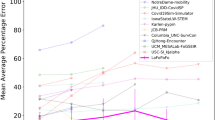Abstract
Methods are sought to test adaptively whether a subpopulation proportion follows the same time evolution as the population proportion. The motivating case study is the COVID-19 screening in a university community, taking into account the time evolution of the pandemic in the whole country.
Access this chapter
Tax calculation will be finalised at checkout
Purchases are for personal use only
Similar content being viewed by others
References
European Center for Disease prevention and Control: COVID-19 clusters and outbreaks in occupational settings in the EU/EEA and the UK (2020)
Buckeridge, D.L., Burkom, H., Campbell, M., Hogan, W.R., Moore, A.W.: Algorithms for rapid outbreak detection: a research synthesis. J. Biomed. Inform. (2005). https://doi.org/10.1016/j.jbi.2004.11.007
Leclère, B., Buckeridge, D.L., Boëlle, P.Y., Astagneau, P., Lepelletier, D.: Automated detection of hospital outbreaks: a systematic review of methods. PLOS ONE (2017). https://doi.org/10.1371/journal.pone.0176438
Tukey, J.: Exploratory Data Analysis. Addison-Wesley Pub, Co (1977)
Hawkins, D.M.: Identification of Outliers. Springer (1980)
Montgomery, D.C.: Introduction to Statistical Quality Control. Wiley (2019)
Brockwell, P.J., Davis, R.A.: Time Series: Theory and Methods. Springer (2009)
Stoica, P., Selen, Y.: Model-order selection. IEEE Sig. Process. Mag. (2004). https://doi.org/10.1109/msp.2004.1311138
Schwarz, G.: Estimating the dimension of a model. Ann. Stat. (1978). https://doi.org/10.1214/aos/1176344136
https://github.com/pcm-dpc/COVID-19/. Cited 20 Dec 2021
Kermack, W.O., McKendrick, A.G.: A contribution to the mathematical theory of epidemics. In: Proceedings of the Royal Society of London. Series A, Containing Papers of a Mathematical and Physical Character (1927). https://doi.org/10.1098/rspa.1927.0118
Amongero, M., Bibbona, E., Mastrantonio, G.: Analysing the Covid-19 pandemic in Italy with the SIPRO model. Book of short papers SIS 2021
Giordano, G., Blanchini, F., Bruno, R., et al.: Modelling the COVID-19 epidemic and implementation of population-wide interventions in Italy. Nat. Med. (2020). https://doi.org/10.1038/s41591-020-0883-7
Giordano, G., Colaneri, M., Filippo, A.D., et al.: Modeling vaccination rollouts, SARS-CoV-2 variants and the requirement for non-pharmaceutical interventions in Italy. Nat. Med. (2021). https://doi.org/10.1038/s41591-021-01334-5
Kerr, C.C., Stuart, R.M., Mistry, D., et al.: Covasim: an agent-based model of COVID-19 dynamics and interventions. PLOS Comput. Biol. (2021). https://doi.org/10.1371/journal.pcbi.1009149
Farcomeni, A., Maruotti, A., Divino, F., Jona-Lasinio, G., Lovison, G.: An ensemble approach to short-term forecast of COVID-19 intensive care occupancy in Italian regions. Biom. J. (2020). https://doi.org/10.1002/bimj.202000189
Fokas, A.S., Dikaios, N., Kastis, G.A.: Mathematical models and deep learning for predicting the number of individuals reported to be infected with SARS-CoV-2. J. R. Soc. Interface (2020). https://doi.org/10.1098/rsif.2020.0494
Kissler, S.M., Tedijanto, C., Goldstein, E., Grad, Y.H., Lipsitch, M.: Projecting the transmission dynamics of SARS-CoV-2 through the postpandemic period. Science (2020). https://doi.org/10.1126/science.abb5793
https://cran.r-project.org/web/packages/forecast/index.html. Cited 20 Dec 2021
Acknowledgements
The authors would like to thank Paola Lerario and Maurizio Galetto for insights and details on the organization of the screening procedure in Politecnico di Torino and Enrico Bibbona for some critical discussions. The authors would like to thank also two anonymous reviewers, who greatly helped to improve the quality of the manuscript.
Author information
Authors and Affiliations
Corresponding author
Editor information
Editors and Affiliations
Rights and permissions
Copyright information
© 2022 The Author(s), under exclusive license to Springer Nature Switzerland AG
About this paper
Cite this paper
Di Stefano, F., Gasparini, M. (2022). Adaptive COVID-19 Screening of a Subpopulation. In: Salvati, N., Perna, C., Marchetti, S., Chambers, R. (eds) Studies in Theoretical and Applied Statistics . SIS 2021. Springer Proceedings in Mathematics & Statistics, vol 406. Springer, Cham. https://doi.org/10.1007/978-3-031-16609-9_8
Download citation
DOI: https://doi.org/10.1007/978-3-031-16609-9_8
Published:
Publisher Name: Springer, Cham
Print ISBN: 978-3-031-16608-2
Online ISBN: 978-3-031-16609-9
eBook Packages: Mathematics and StatisticsMathematics and Statistics (R0)




